A nutritional spin on dinner

Danny Kopel strikes a pose on his instructor bike following a SoulCycle class in Union Square. Photo: Brittany Robins.
Danny Kopel stands on the podium, the spotlight shining on his small, spandex-clad frame and frosted-tip hair. The lights fade, the candles flicker and thumping music rages on as 60 people pedal atop stationary bikes.
Kopel, 28, is an instructor at SoulCycle, a popular indoor cycling studio with 13 locations across New York City and 50,000 riders per week, according to the company website.
As an instructor, Kopel is more Cirque du Soleil than drill sergeant, punctuating songs with quirky acrobatics like high kicks and split jumps. He started out as a rider in 2009. A year later, his instructor signed him up to audition for a teaching position, and he has been an instructor ever since.
Following the 45-minute sweat session at the Union Square location, the second of two classes he taught in one day, he takes the L train to Williamsburg with his boyfriend, Austin Bone, 29, to prepare a home-cooked meal. Bone rides in Kopel’s evening classes as a prelude to their standing dinner date. The couple lives with their cat, Yoko Kopel Bone, and dines together every night.

Family shot of Kopel, Bone and their cat Yoko. Photo: Brittany Robins.
“It’s sort of the only quality time we have during the day,” says Bone, who works for Snaps, a startup and app that superimposes virtual content onto photos. Kopel’s upbringing in Puerto Rico was shaped by family dinners, but Bone’s family in Georgia seldom dined together, so they make it a priority to catch up on the day’s events at the dinner table.
Getting off at the Bedford Avenue stop, they head to a nearby grocery store, loading their cart with kale, broccoli, sweet potato, carrots and quinoa. Kopel sneaks two bags of chocolate-covered pretzels into the mix. “Don’t judge me,” he says, “they’re not for me, I swear!”
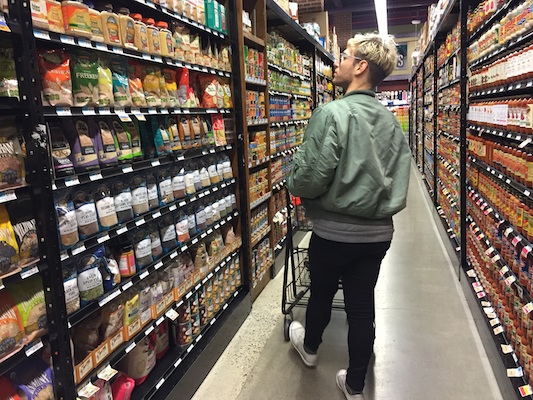
Kopel peruses the grocery aisle for quinoa. Photo: Brittany Robins.
Their apartment in a high-rise building resembles a museum—from the pristine white walls to the modern light fixtures and vibrant artwork. Asymmetrical shelves that the pair built from scratch coil up one wall, filled with books on art and culture.
Dinner is a macrobiotic plate, a signature dish they prepare twice a week. “It’s basically steamed vegetables; carrots, sweet potato, broccoli and kale, quinoa and black-eyed peas,” says Kopel, peeling the sweet potato. Bone scrapes the outer skin of the carrots.
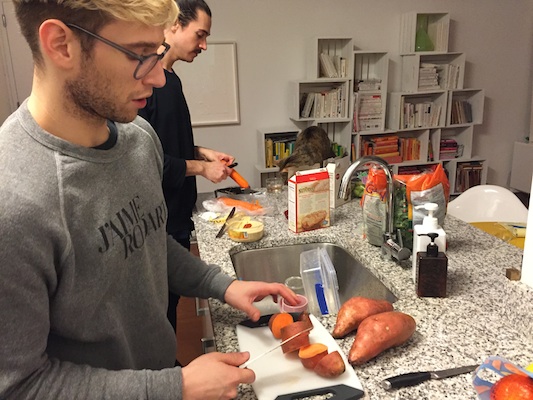
Kopel slices the sweet potatoes while Bone scrapes the skin of the carrots. Photo: Brittany Robins.
“I wouldn’t say it’s tasty,” says Kopel, “but you can taste each vegetable for what it is—you don’t want to disguise anything with a lot of flavor. It’s pretty earthy.”
Kopel first had the dish five years ago, when he was a vegan and frequented a vegetarian restaurant called Souen. “Souen was my go-to every day. I always ordered a macrobiotic plate,” he says. He then figured out a way to recreate it at home. “I don’t have a steamer because they’re too bulky, so we chop the veggies up, put them in a pot with water, olive oil, kosher salt and that’s basically it.”
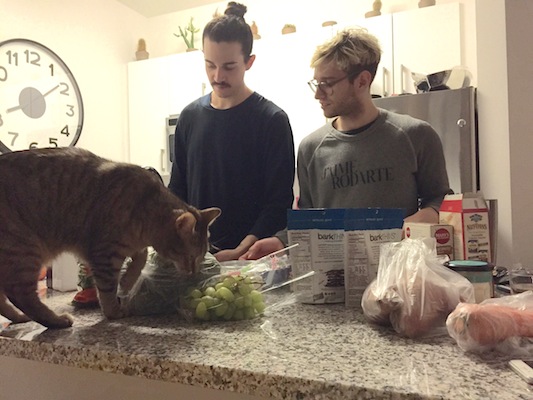
The couple puts the finishing touches on their meal. Photo: Brittany Robins.
Since many of the vitamins and minerals in vegetables are water-soluble and heat-sensitive, nutrients can leach out when boiled, according to a recent study in the Journal of Food Science. Some suggest that drinking the cooking water is a viable solution, but Kopel chooses to dump the water.
“Losing nutrients from cooking vegetables is one of the arguments behind the raw food movement,” he says, “but it can be confusing to know what to believe, so I just follow whatever gives me energy.”
Kopel is more enthralled by the mystique of macrobiotics than the actual plate of food; he views it as a quixotic Japanese lifestyle philosophy.
“I think it’s about keeping your body in tune with the seasons, so if it’s winter, you shouldn’t eat mango because it has a cooling effect on the body. It’s about eating seasonally and not taking the ceremony of eating for granted.” He recalls that Madonna was famously macrobiotic at a point in time. “That might’ve been why it initially appealed to me—hashtag my queen,” he laughs.
He is no longer a vegan, thanks to his boyfriend’s influence.
“Now I don’t have any restrictions—I’ll try almost anything,” he says, plopping the root vegetables into the pot as Bone stirs quinoa into a separate vessel.
“I feel sustained for a longer period of time than I did on just vegetables and grains, which has more fiber and moves through your body a lot faster,” says Kopel, who teaches nine classes per week and does strength training twice a week.
In between the slicing and stirring, the couple discusses their nostalgia for antiquated technologies like flip phones and iPods. They banter about where each would like to live when they grow old. Kopel says somewhere rural; Bone’s vote is for outer space.
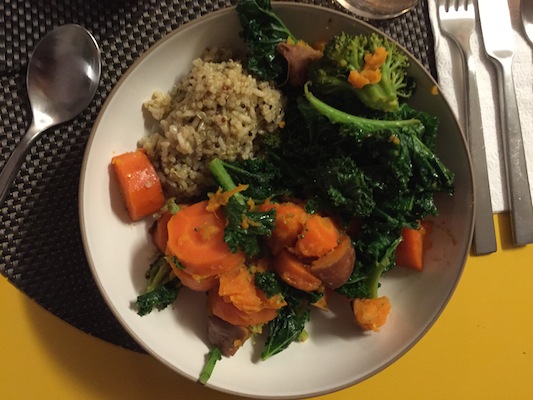
The macrobiotic plate consists of steamed carrots, sweet potato, kale, broccoli and quinoa. Photo: Brittany Robins.
Kopel wasn’t always health-conscious. He grew up in Puerto Rico to a Cuban mother and a father of Cuban and Polish-Jewish descent. His entire family struggled with weight.
“Growing up, I was never really taught balance,” he says, adding the broccoli to the pot. “We were a food-loving family that congregated around the kitchen. It was not a meal unless you were eating a dead animal and a starch.” He says he culturally identifies as Cuban, based on the foods his mother routinely cooked for the family.
“Rice and beans is the staple of Latin food, but my favorite was lasagna with fried plantains and ground beef. It’s sweet and savory,” he says, with a nostalgic grin.
But once he moved to New York in 2005 for college, he began exercising and revamped his diet. “Through learning balance, I learned to dissociate guilt from food and that was an eye-opener,” he says.
Kopel likes the challenge of serving the fast-paced New York clientele.
“New Yorkers often feel like there’s too much on their plate. SoulCycle gives people a moment to focus on one thing and that’s why it’s powerful,” he says. “People don’t make eye contact on the street, so to feel a sense of togetherness is important in big cities.”
As a last-minute garnish, Kopel blends olive oil and mayonnaise into a jar of tahini paste to make tahini sauce. He puts the plates of colorful food on the round, yellow table. Bone places a spotlight lamp on the table for dramatic effect.
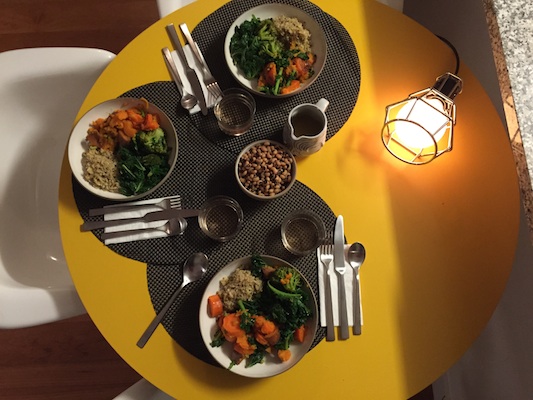
The macrobiotic plates are served for dinner with a side of black-eyed peas, tahini sauce and rosé. Photo: Brittany Robins.
“I guess the caveat of having a diet that doesn’t have restrictions is that sometimes you can err on the side of being more indulgent,” Kopel says. Then, he tops off his fourth glass of rosé.

Your Comments